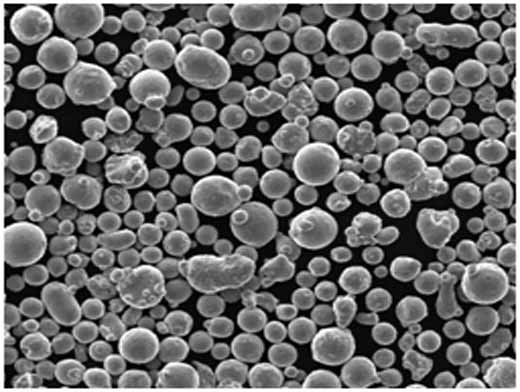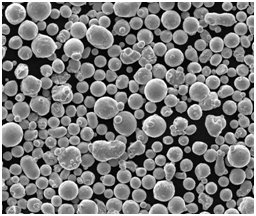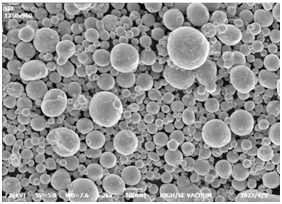Visão geral de Impressão 3D com jato de aglutinante
Esta tecnologia é particularmente vantajosa em indústrias onde precisão, eficiência e flexibilidade de material são críticas. Seja aeroespacial, automotiva ou mesmo saúde, a Impressão 3D por Jato de Aglutinante está causando impacto ao oferecer uma solução econômica e escalável para a produção de componentes metálicos complexos.
A Ciência por Trás da Impressão 3D por Jato de Aglutinante
O Jato de Aglutinante opera com um princípio relativamente simples. Um aglutinante — um adesivo líquido — é depositado seletivamente em uma camada de pó, camada por camada. As áreas onde o aglutinante é aplicado endurecem para formar a forma desejada, enquanto o pó circundante permanece solto e pode ser reutilizado. Uma vez que o objeto está totalmente formado, ele passa por uma etapa de pós-processamento, como a sinterização, para atingir sua densidade e resistência finais.
Como Funciona a Impressão 3D por Jato de Aglutinante?
Etapa 1: Camada do Pó
- : Uma fina camada de pó metálico é espalhada pela plataforma de construção.Etapa 2: Ligação
- : Uma cabeça de impressão deposita seletivamente o aglutinante sobre o pó, formando a forma da peça.Etapa 3: Repetição
- : O processo se repete, camada por camada, até que toda a peça seja construída.Etapa 4: Cura
- : A peça é deixada para curar, solidificando o aglutinante.Etapa 5: Sinterização
- : A etapa final envolve o aquecimento da peça em um forno para fundir as partículas do pó, atingindo as propriedades mecânicas desejadas.Impressão 3D por Jato de Aglutinante 9

Funciona com uma ampla gama de pós metálicos, incluindo aço inoxidável, titânio e Inconel.
| Característica | Descrição |
|---|---|
| Versatilidade de materiais | Mais rápido do que outros métodos de impressão 3D de metal, pois não requer a fusão do material. |
| Velocidade | Menores custos operacionais devido ao menor consumo de energia e à capacidade de reutilizar o pó. |
| Custo-efetividade | Geralmente requer pós-processamento para obter acabamentos lisos. |
| Acabamento da superfície | Resistência da Peça |
| Comparável às peças fabricadas tradicionalmente após a sinterização. | Bem adequado para produzir várias peças simultaneamente. |
| Escalabilidade | Eficiência na Produção |
Vantagens de Impressão 3D com jato de aglutinante
- : Em comparação com métodos como SLM (Fusão Seletiva a Laser), o Jato de Aglutinante é mais rápido e consome menos energia, tornando-o ideal para produção em larga escala.: Capaz de usar vários pós metálicos, incluindo aço, alumínio e até materiais cerâmicos, tornando-o versátil para diferentes indústrias.
- : Com menores requisitos de energia e a capacidade de reutilizar o pó não ligado, o Jato de Aglutinante é frequentemente mais econômico do que outros métodos de impressão 3D.: Este método gera menos desperdício e tem uma pegada de carbono menor, pois não envolve lasers de alta energia ou feixes de elétrons.
- Custo-benefícioPós Metálicos Específicos Usados na Impressão 3D por Jato de Aglutinante
- Impacto ambientalO Jato de Aglutinante pode funcionar com uma impressionante gama de pós metálicos. Abaixo, exploramos alguns modelos específicos:
Conhecido por sua excelente resistência à corrosão e propriedades mecânicas, tornando-o ideal para aplicações marítimas e médicas.
Oferece alta resistência e dureza, amplamente utilizado nos setores aeroespacial e militar.
| Modelo de pó metálico | Descrição |
|---|---|
| Aço inoxidável 316L | Uma superliga à base de níquel com excelente resistência a altas temperaturas, frequentemente usada na indústria aeroespacial. |
| Aço inoxidável 17-4 PH | Outra liga à base de níquel, altamente resistente à oxidação e corrosão, adequada para ambientes extremos. |
| Inconel 625 | Extremamente durável e biocompatível, tornando-o perfeito para implantes dentários e ortopédicos. |
| Inconel 718 | Oferece excelente condutividade elétrica e térmica, usado em eletrônicos e trocadores de calor. |
| Cobalto-cromo | Leve com alta resistência e resistência à corrosão, comumente usado em implantes aeroespaciais e médicos. |
| Cobre | Leve e durável, ideal para peças automotivas e aeroespaciais onde a redução de peso é crítica. |
| Titânio Ti6Al4V | Conhecido por sua resistência ao desgaste e baixo atrito, frequentemente usado em rolamentos e buchas. |
| Alumínio AlSi10Mg | Alta densidade e resistência à temperatura, adequado para aplicações que exigem alta estabilidade térmica, como no setor aeroespacial. |
| Bronze | Composição dos Pós de Impressão 3D por Jato de Aglutinante |
| Tungstênio | Alta resistência à corrosão, boa soldabilidade. |
Alta resistência, boa dureza, resistência à corrosão.
| Pó metálico | Componentes primários | Propriedades |
|---|---|---|
| Aço inoxidável 316L | Ferro, cromo, níquel, molibdênio | Excelente resistência a altas temperaturas, resistência à corrosão. |
| Aço inoxidável 17-4 PH | Ferro, cromo, níquel, cobre | Níquel, Cromo, Ferro, Nióbio, Titânio |
| Inconel 625 | Níquel, cromo, molibdênio, nióbio | Resistência à oxidação, estabilidade em altas temperaturas. |
| Inconel 718 | Biocompatibilidade, resistência ao desgaste, alta resistência. | Leve, resistência à corrosão, biocompatível. |
| Cobalto-cromo | Cobalto, cromo, molibdênio | Leve, boas propriedades mecânicas. |
| Cobre | Cobre | Alta condutividade elétrica e térmica. |
| Titânio Ti6Al4V | Titânio, alumínio, vanádio | Baixo atrito, resistência ao desgaste, anticorrosivo. |
| Alumínio AlSi10Mg | Alumínio, silício, magnésio | Alto ponto de fusão, alta densidade, resistência. |
| Bronze | Cobre, estanho | Impressão 3D por Jato de Aglutinante 10 |
| Tungstênio | Tungstênio | Ponto de fusão alto, alta densidade, resistência. |






Aplicativos de Impressão 3D com jato de aglutinante
O Jato de Aglutinante é usado em vários setores, onde cada modelo de pó metálico serve a propósitos distintos.
| Setor | Aplicativo | Modelo de pó metálico |
|---|---|---|
| Aeroespacial | Componentes de motor, pás de turbina | Inconel 625, Inconel 718 |
| Automotivo | Peças leves, protótipos | Alumínio AlSi10Mg, Titânio Ti6Al4V |
| Médico | Implantes ortopédicos, ferramentas cirúrgicas | Titânio Ti6Al4V, Cobalto-Cromo |
| Marinha | Peças resistentes à corrosão | Aço inoxidável 316L |
| Eletrônicos | Dissipadores de calor, conectores | Cobre |
| Militar | Componentes de armas, blindagem | Aço inoxidável 17-4 PH |
| Energia | Pás de turbina, componentes nucleares | Inconel 625, Tungstênio |
| Joias | Joias de metal personalizadas | Bronze, Cobalto-Cromo |
| Industrial | Rolamentos, buchas | Bronze, Aço Inoxidável 316L |
| Construção | Peças estruturais, conexões | Aço Inoxidável 316L, Alumínio AlSi10Mg |
Especificações e padrões para pós metálicos
A compreensão das especificações, tamanhos e padrões para pós metálicos utilizados na impressão 3D por jato de aglutinante é crucial para garantir que o produto final atenda aos requisitos de qualidade e métricas de desempenho.
| Modelo de pó metálico | Tamanho da partícula (Microns) | Densidade (g/cm³) | Temperatura de sinterização (°C) | Padrões |
|---|---|---|---|---|
| Aço inoxidável 316L | 15-45 | 7.9 | 1250-1400 | ASTM A276, A240 |
| Aço inoxidável 17-4 PH | 20-53 | 7.7 | 1200-1300 | AMS 5604, ASTM A564 |
| Inconel 625 | 15-45 | 8.4 | 1250-1400 | ASTM B443, B446 |
| Inconel 718 | 15-53 | 8.19 | 1250-1400 | AMS 5596, ASTM B637 |
| Cobalto-cromo | 10-45 | 8.3 | 1150-1350 | ASTM F75 |
| Cobre | 15-45 | 8.96 | 1080-1125 | ASTM B152 |
| Titânio Ti6Al4V | 20-53 | 4.43 | 1250-1400 | ASTM F1472, AMS 4911 |
| Alumínio AlSi10Mg | 20-63 | 2.67 | 555-630 | EN 1706, ISO 3522 |
| Bronze | 10-45 | 8.7 | 900-950 | ASTM B505 |
| Tungstênio | 5-45 | 19.3 | 1500-1700 | ASTM B777 |
Impressão 3D por jato de aglutinante: Prós e contras
Para entender completamente os benefícios e limitações da impressão 3D por jato de aglutinante, é essencial avaliar os prós e contras.
| Vantagens | Desvantagens |
|---|---|
| Velocidade: Processo de produção rápido | Pós-processamento: Requer etapas adicionais para densificação |
| : Com menores requisitos de energia e a capacidade de reutilizar o pó não ligado, o Jato de Aglutinante é frequentemente mais econômico do que outros métodos de impressão 3D.: Ampla gama de pós utilizáveis | Acabamento da superfície: Frequentemente necessita de usinagem secundária |
| Custo-efetividade: Baixos custos operacionais | Força: As peças podem ser menos densas sem sinterização adequada |
| Escalabilidade: Adequado para produção em massa | Porosidade: Potencial para maior porosidade em comparação com outros métodos |
| Impacto ambiental: Baixa produção de resíduos | Restrições de design: Limitado pela fluidez do pó e adesão das camadas |
Principais fornecedores de pós metálicos para Impressão 3D com jato de aglutinante
A disponibilidade de pós metálicos de alta qualidade é crucial para o sucesso da impressão 3D por jato de aglutinante. Abaixo estão alguns dos principais fornecedores e seus detalhes de preços.
| Fornecedor | Modelos de pó metálico disponíveis | Faixa de preço (USD/kg) | Localização |
|---|---|---|---|
| Höganäs AB | Aço inoxidável 316L, Aço inoxidável 17-4 PH | 50-100 | Suécia |
| Aditivo GKN | Inconel 625, Inconel 718 | 200-400 | EUA |
| Aditivo Carpenter | Titânio Ti6Al4V, Cobalto-Cromo | 250-500 | EUA |
| Sandvik Osprey | Alumínio AlSi10Mg, Bronze | 60-150 | REINO UNIDO |
| Tecnologia LPW | Tungstênio, Cobre | 100-250 | REINO UNIDO |
| AP&C | Titânio Ti6Al4V, Inconel 718 | 300-600 | Canadá |
| Tekna | Alumínio AlSi10Mg, Cobre | 50-200 | Canadá |
| Arcam AB | Cobalto-Cromo, Titânio Ti6Al4V | 200-450 | Suécia |
| Erasteel | Aço inoxidável 316L, Bronze | 80-180 | França |
| PyroGenesis | Tungstênio, Inconel 625 | 150-300 | Canadá |
Comparando a impressão 3D por jato de aglutinante com outras tecnologias de impressão 3D
Ao considerar o jato de aglutinante para suas necessidades de produção, é essencial compará-lo com outros métodos populares de impressão 3D, como fusão seletiva a laser (SLM) e fusão por feixe de elétrons (EBM).
| Tecnologia | Velocidade | Faixa de material | Acabamento da superfície | Custo | Aplicações típicas |
|---|---|---|---|---|---|
| Jateamento de ligantes | Rápido | Ampla (metais, cerâmicas) | Áspero, requer pós-processamento | Baixo (devido à economia de energia) | Produção em massa, prototipagem |
| Fusão seletiva a laser (SLM) | Moderado | Metais | Suave, detalhado | Alto (devido ao uso de energia) | Aeroespacial, implantes médicos |
| Fusão por feixe de elétrons (EBM) | Lento | Limitado (principalmente metais) | Áspero, mas de alta resistência | Alto (devido ao custo do equipamento) | Aeroespacial, peças personalizadas |

perguntas frequentes
| Pergunta | Resposta |
|---|---|
| Que materiais podem ser usados na impressão 3D por jato de aglutinante? | Uma ampla gama de metais, cerâmicas e compósitos pode ser usada, incluindo aço inoxidável, titânio e Inconel. |
| O jato de aglutinante é mais rápido do que outros métodos de impressão 3D de metal? | Sim, geralmente é mais rápido, pois não requer a fusão de materiais, o que acelera o processo significativamente. |
| A impressão 3D por jato de aglutinante produz peças fortes? | Sim, após a sinterização adequada, as peças podem atingir uma resistência comparável àquelas feitas por meio de métodos de fabricação tradicionais. |
| Quais são as principais indústrias que usam o jato de aglutinante? | As indústrias aeroespacial, automotiva, médica e eletrônica são alguns dos setores-chave que utilizam essa tecnologia. |
| O pós-processamento é sempre necessário no jato de aglutinante? | Normalmente, sim. O pós-processamento, como sinterização ou infiltração, é necessário para melhorar as propriedades mecânicas e o acabamento das peças. |
| Como o jato de aglutinante se compara em custo a outros métodos? | Geralmente é mais econômico devido aos menores requisitos de energia e à capacidade de reutilizar pós. |

